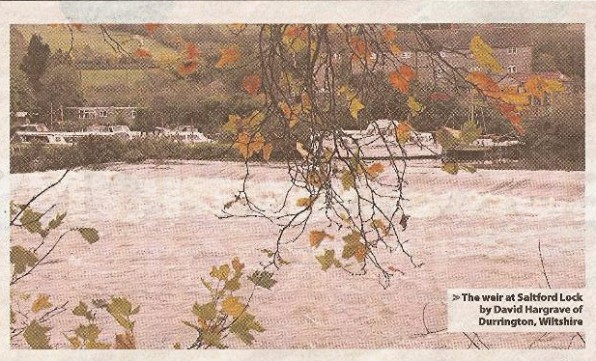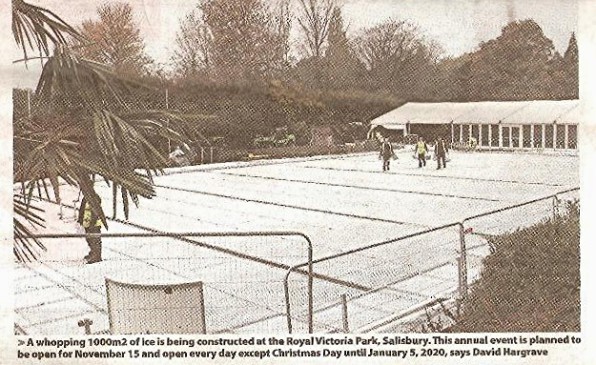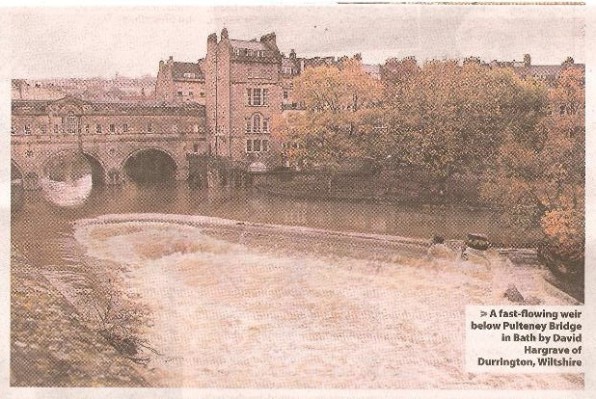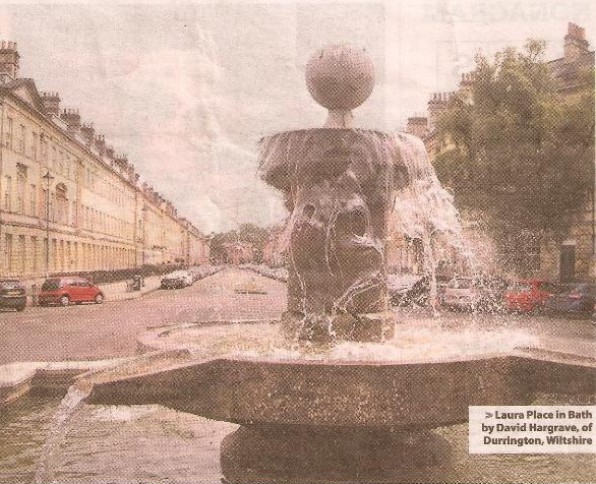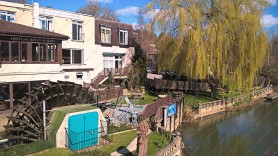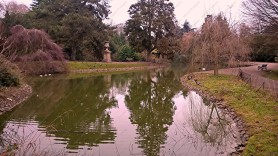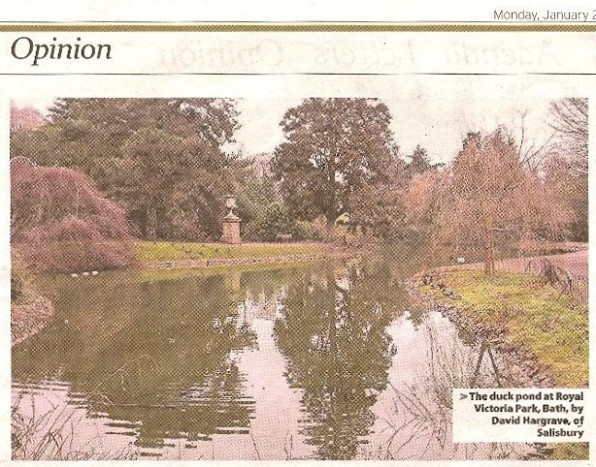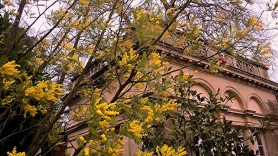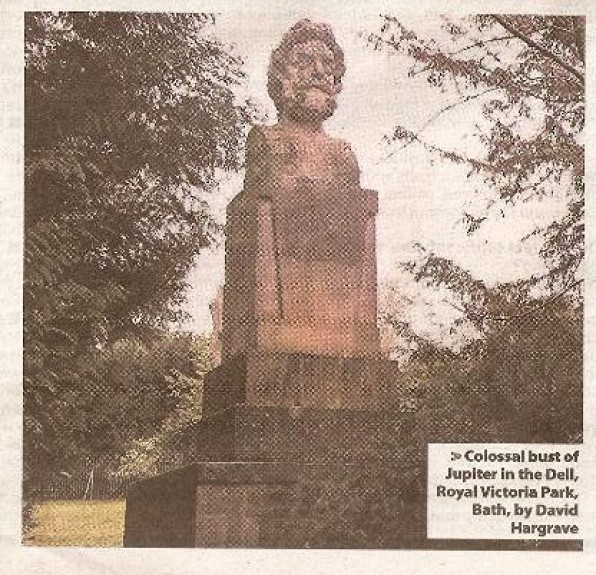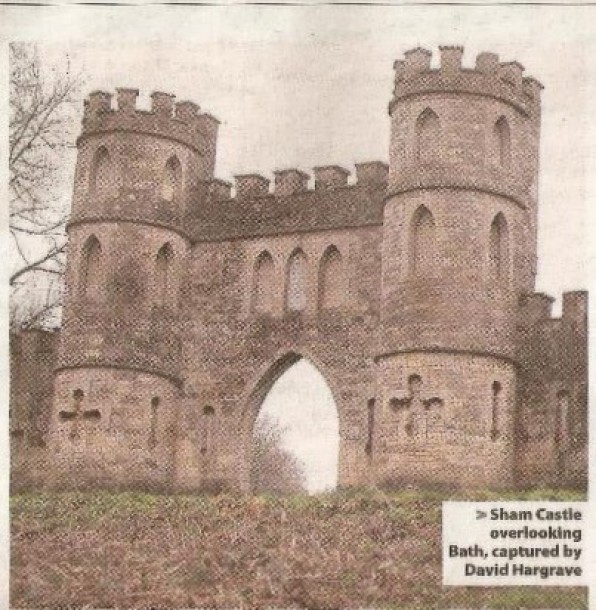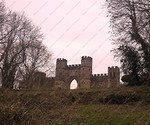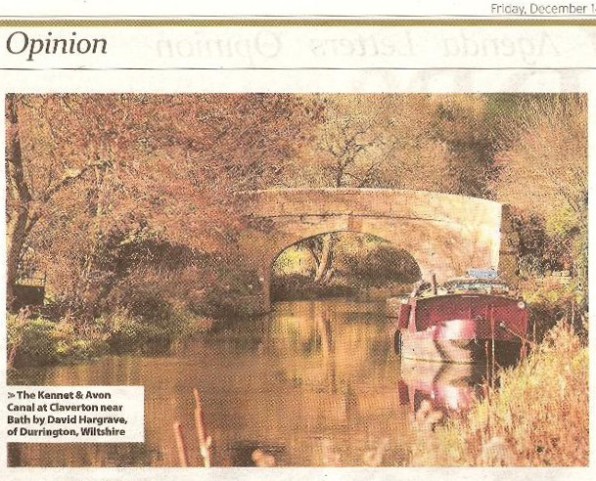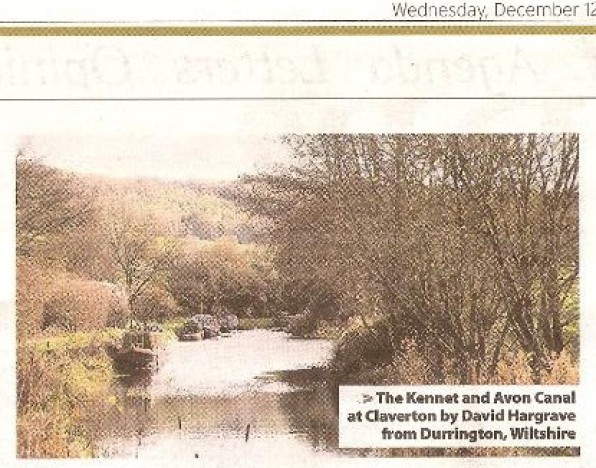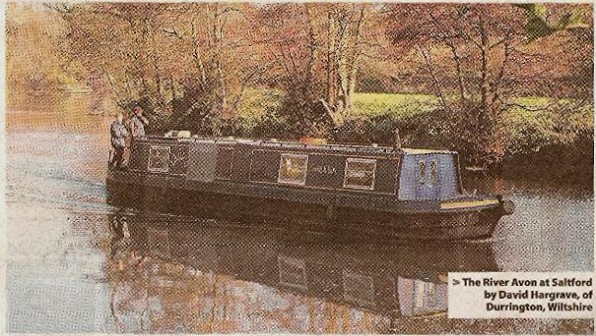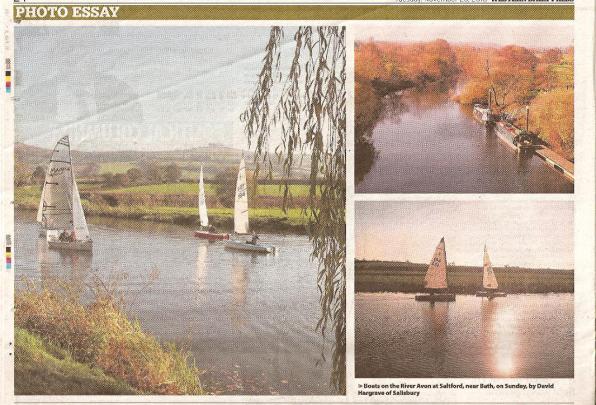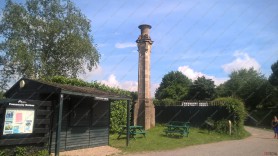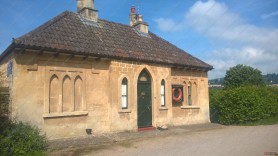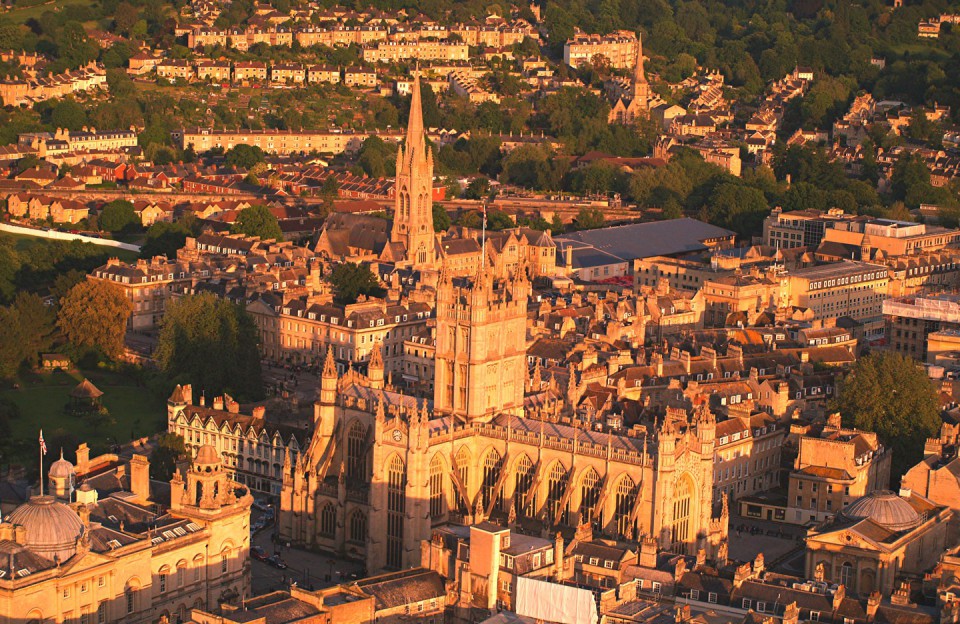
Bath
Laura Fountain - Great Pulteney Street, Bath - 23.06.19
Fountain 11/08/72
GV II
Fountain. 1877, reconstructed 1977, only basin remains of original design. By AS Goodridge. MATERIALS: Limestone. PLAN: Square plan with segmental bays to each facet almost forming circle. EXTERIOR: Outer bowl has rounded coping and moulded plinth with small colonnettes carved into angles. Centre is pedestal with shallow straight-sided bowl with chutes protruding toward angles below cylindrical shaft to similar smaller bowl and C20 lead ball finial that replaces former gadrooned urn. HISTORY: Fountain was erected in 1877 to mark Centenary of Bath and Western Counties Agricultural Society, but this was to very different design from today. Fountain was reconstructed in 1977 to mark Bicentenary (see photographs for its original appearance and the opening in 1877). Centre of Laura Place had been proposed for a column to commemorate Nelson in 1805; and for a "Reform pillar" to be designed by HE Goodridge in 1832: the Pulteneys had always been a family with Whig sympathies. SOURCES: (The Bath Chronicle: Images of Bath: Derby: 1994 -)
Bath Recreation Ground - 23.06.19
History of BathRec taken from their website: www.bathrec.co.uk
Pre 1894
The Recreation Ground and land off North Parade were part of the Bathwick Estate held by the Forester family.
1894
Captain G W Forester granted a lease to the Directors of the Bath and County Recreation Ground Company Limited. This allowed the company to execute such works as should render it suitable for
cricket matches, lawn tennis, archery tournaments, football matches and other outdoor sports (including the first Bath Rugby matches on the Recreation Ground). The works included building a
pavilion on the north side of the Recreation Ground.
1897
The first ever Somerset County Cricket festival (also known as the Bath Cricket Festival) was held. This event ran more or less continuously from 1897.
1908
A further lease was granted to the Directors of the Bath and County Recreation Ground Company Limited for a term of 21 years at a rent of £100 per year.
1922
The Recreation Ground and the North Parade land were conveyed by the trustees of the Forester estate to the Bath and County Recreation Ground Company Limited for a price of £6,050. The Deed of
conveyance included restrictive covenants (the 1922 covenants).
The North Parade land then included a building known as 'the Pavilion' which was used as an ice skating rink. The company then conveyed the North Parade land to Bath
Aircraft Limited for the sum of £2,500.
1927
A lease was granted to Bath Football Club for land on the west of the Recreation Ground, together with a grandstand, a new north stand and a pavilion, for a term of 25 years.
1930
Bath Aircraft Limited conveyed the North Parade land to the Mayor Aldermen and Citizens of the City of Bath (the Corporation) for a price of £4,500.
1933
A new west stand was erected (in place of the grandstand) on the land used by Bath Football Club. The 1927 lease was surrendered and a new lease granted for a further 50 years.
1942
The west stand was extensively damaged by bombing during the blitz.
1953/54
The west stand was rebuilt. The cost of more than £12,000 was met by the War Damage Commission.
1954
Agreement was given for the erection of a building called 'the Club Room' to the west of the north stand on the land used by Bath Football Club. A lease was also granted to James Colmer Limited
for land in the north east corner of the Recreation Ground together with a pavilion to be used for the purposes of a tennis club.
1956
The Recreation Ground was conveyed to the Mayor Aldermen and Citizens of the City of Bath (the Corporation) on the 1st February 1956 for £11,155.
1973
The 1933 lease was surrendered and a new 75 year lease granted to Bath Football Club.
1974
On the reorganisation of local government, the Recreation Ground and the North Parade land were transferred to Bath City Council.
1975
The Sports and Leisure Centre was erected by the Bath City Council on the south side of the Recreation Ground with an access over the North Parade land.
1995
A new 75 year lease was granted to Bath Football Club.
2002
Doubts over the legal effect of the 1956 Conveyance were settled when the High Court declared the Recreation Ground to be a charitable trust, with the Council as its trustee. The Charity
Commission initiated an investigation and appointed interim managers.
2006
The Council commenced a Strategic Review to consider how to resolve the legal issues and to establish the best way forward.
2007
The management of the Trust was handed back to the Council. This role was carried out through a Trust Board of three councillors. The title of the land was vested in the Official
Custodian. The Strategic Review was published. Consultation revealed that a majority of respondents were in favour of varying the existing usage.
2008 - 2010
The Trust developed proposals involving the retention of both the Rugby Club and the Leisure Centre on the Recreation Ground. Additional land would be acquired to replace the area affected by
the Rugby Club's lease.
2011
Consultation on the Trust's proposals showed strong public support. The Trust presented its proposals to the Charity Commission.
2012
The Charity Commission published a draft Scheme to give effect to the proposals. The Trust published an accompanying explanatory booklet. There was again strong public support but also a
significant minority of objections.
2013
The Charity Commission's final Scheme was published. A new, independent trustee body was created and provided with the powers to implement the proposals. The Council was made the
custodian trustee. The new trustees were appointed and commenced discussions with Bath Rugby and the Council. In the meantime, an appeal was lodged against the Scheme.
2014
The Appeal was heard by the First-Tier Tribunal and the Scheme was amended to substantially limit the Trust's powers. The Trust appealed against the decision of the First-Tier
Tribunal.
Interim agreements were made with Bath Rugby. Negotiations commenced with the Council for a lease to regularise the position of the leisure Centre. Support services from the Council were
concluded and a General Manager, Office Manager and Groundsman were appointed by the Trust.
2016
The First Tier Tribunal issued a final Scheme in December 2016. This brought to an end the long running legal matters and paved the way for future strategy to focus on the Charity's
Objects. The General Manager was re-appointed as Chief Executive and the Trust began the process of Incorporation.
2018
Bath Recreation Limited was incorporated on 2 January 2018. The Charitable Company subsumed Bath Recreation Ground Trust and all operations. Bath Recreation Ground Trust is
now a linked Charity to Bath Recreation Limited to hold the Title of Bath Recreation Ground only. Bath Recreation Limited became the operating Charity and is the sole Trustee of Bath Recreation
Ground Trust.
Fudge Kitchen - Bath - 23.06.19
Whilst on my walkaround of Bath, preparing for Bath in Bloom I came across this guy!
Information taken from website - fudgekitchen.co.uk/en/about-us
At Fudge Kitchen we’ve been hand-crafting our original special recipe fudge for over 35 years, using traditional methods and a lot of love. You’ll find our fudge is devilishly different to any that you’ve ever tasted before. It’s made with fresh whipping cream which makes it smooth, soft, creamy and delicious. We also offer our own unique version of Gourmet Butter Fudge (only available online), jars of luxury Fudge Sauce, selections of Drinking Fudge, Fudge Making Kits and Fudge Experiences at our High Street Shops. Our fudge is made with natural ingredients, no preservatives, is vegetarian friendly and gluten free (unless stated) and may contain nuts due to manufacturing methods. Vegan flavours are available.
Bath Paddleboard Centre - 24.03.19
Whilst out and about I saw these people on the Kennett & Avon canal from the Bath Paddleboard Centre.
(Taken from website) - Stand up paddleboarding (SUP) is currently the fastest growing sport in the world today - and once you've tried it for yourself you'll see
why. SUP doesn't require large amounts intensive dry land instruction before you get a chance to get on the water.
There's just a few basics to grasp and then you're out having fun! Check them out here www.bathpaddleboardcentre.co.uk
Dundas Aqueduct - Limpley Stoke - 24.03.19
HMS Heron’s narrowboat was seen on the canal today at Limpley Stoke.
HMS Heron’s Narrowboat Warneford VC is a 70ft Owl Class canal boat that sleeps up to 10 people. HMS Heron’s narrowboat is moored on the Kennet and Avon Canal
near Trowbridge, which puts it within easy reach of Bradford-on-Avon and Bath.
The narrowboard bears the name of a hero who won the VC, Reginald Warneford.
Warneford's initial training took place at Hendon, passing then to Upavon in Wiltshire where he completed his pilot training on 25 February 1915. During the course
of training, the Commander of Naval Air Stations, R M Groves was quoted as saying: "This youngster will either do big things or kill himself." Warneford's flying instructor at the time, Warren
Merriam, noted his skills as a pilot but had to make special arrangements to ensure that Warneford's perceived over-confidence did not bar him from attaining a commission.
Merriam took an opportunity whilst Commander Groves was visiting Hendon to ask Warneford to demonstrate his flying skills. Groves' favourable impression overcame the
views of the Squadron Commander at the time who believed that Warneford would never make an officer because of his lack of discipline.
Warneford was initially posted to 2 Wing on the Isle of Sheppey in Kent but was quickly (7 May 1915) posted to an operational unit with 1 Wing at Veurne on the Belgian
coast. Over the next few weeks, Warneford was involved in attacks on German troops and guns, as well as actions against enemy aircraft. His aggressiveness and effectiveness led to his being given his
own aircraft and a roving commission.
On 17 May 1915, Warneford encountered a Deutsches Heer-flown Zeppelin airship, LZ 39, setting out on a raid over the UK. He attacked LZ39 with machine gun fire but the
airship was able to ascend out of range by jettisoning ballast.
On 7 June 1915 at Ghent, Belgium, Warneford, flying a Morane-Saulnier Type L, attacked another German Army airship, LZ 37. He chased the airship from the coast near
Ostend and, despite its defensive machine-gun fire, succeeded in dropping his bombs on it, the last of which set the airship on fire.
LZ37 subsequently crashed in Sint-Amandsberg. The explosion overturned Warneford's aircraft and stopped its engine. Having no alternative, Warneford had to land behind
enemy lines, but after 35 minutes spent on repairs, he managed to restart the engine and returned to base.
On 17 June 1915, Warneford received the award of Légion d'honneur from the French Army Commander in Chief, General Joffre.
Following a celebratory lunch, Warneford travelled to the aerodrome at Buc in order to ferry an aircraft for delivery to the RNAS at Veurne.
Having made one short test flight, he then flew a second flight, carrying an American journalist, Henry Beach Newman, as passenger.
During a climb to 200 feet, the right hand wings collapsed leading to a catastrophic failure of the airframe. Accounts suggest that neither occupant was harnessed and
were both thrown out of the aircraft, suffering fatal injuries. In the case of Newman, death was instantaneous.
Warneford died of his injuries on the way to hospital.
He was buried at Brompton Cemetery, London on 21 June 1915 in a ceremony attended by thousands of mourners. The grave lies in front of the eastern colonnade.
His Victoria Cross is displayed at the Fleet Air Arm Museum in Yeovil, Somerset, England.
Medal entitlement of Flight Sub-Lieutenant Reginald Warneford,
1 Squadron, Royal Naval Air Service
Victoria Cross
1914-15 Star
British War Medal ( 1914-20 )
Victory Medal ( 1914-19 )
Knight, Legion of Honour ( France )
Bathampton & Bathampton Water Wheel - 24.03.19
A hydro-electric scheme has replaced a decorative wooden water wheel at Bathampton Weir.
Bath & North East Somerset Council is investing in the part community-owned energy project on the River Avon. The council is making a loan to the Old Mill
Community Hydro project at the Old Mill Hotel next to the Toll Bridge.
The project has been developed by community enterprise Bath & West Community Energy (BWCE) in partnership with Mongoose Energy.
The existing decorative water wheel at the site, which was installed around 1987, has been replaced with a new modern water wheel, capable of generating enough
electricity to meet the annual demand from more than 20 typical homes.
The water wheel includes screens to protect fish and eels in the river.
Royal Victoria Park - January 2019
These photographs were taken over the last 2 weeks in the Royal Victoria Park Bath. The stone urn by the duck pond dates from the 1830’s.
Royal Victoria Park must be the finest park and public adventure play area for miles; there really is something for everyone. The adventure play area is very impressive, with thrilling and imaginative equipment grouped roughly according to age group. There are slides, swings, elaborate climbing frames, a sand pit, tunnel slides, a large tyre swing and much more. A skateboard area satisfies the needs of any budding skating pro. At peak times during the summer there is a ‘pay’ bouncy castle and roundabout. Parents’ minds can rest, as there is a lost children area as well as an all day park Supervisor.
A pond provides the perfect place to float model boats and the old park tradition of duck feeding.
Beneath the Royal Crescent, you can expect to watch spectacular hot air balloon take-offs after 6pm. There is also a bowling green, pitch and putt, tennis courts and of
course a small café if all that’s tired you out!
There are plenty of perfect picnic spots a long with masses of space for games of football, cricket, rounders and any other game that requires a large open
area.
Royal Victoria Park hosts numerous annual events including The Bath Festival and The Children’s Festival (May Bank Holiday weekend) along with the occasional visit from
circuses and fairs.
The Botanical Gardens at Royal Victoria Park in January 2019
These photographs were taken during January 2019. The Colossal bust of Jupiter is in the Dell, Royal Victoria Park.
One of the most delightful features of Royal Victoria Park, The Botanical Gardens were formed in 1887, and within their nine acres are many choice trees, shrubs, a fine herbaceous border, a rock garden and pool, a scented walk, a collection of old shrub roses, and a replica of a Roman Temple.
You will find the walkways, which wind in and out of the planted areas, full of interest and colour, and alive with birds, insects, butterflies and wildlife.
A small stream bubbles over stones and under small bridges, and there is a large, fish filled pond with a moorhen house. There are many benches dotted around for you to
sit and enjoy a little peace and quiet, away from the bustle of the city centre.
To mark its centenary in 1987, the gardens were extended to include the Great Dell, a disused quarry and formerly part of the park itself, which already contained a very
fine collection of conifers. It has since been developed into a beautiful woodland garden with an aerial walkway, which provides a series of breathtaking viewpoints amongst the trees and right across
Royal Victoria Park.
Sham Castle - 06.01.19
Sham Castle is a folly in gothic style on Claverton Down overlooking the city of Bath. It is a Grade II listed building. It is a screen wall with a central
pointed arch flanked by two 3-storey circular turrets, which extend sideways to a 2-storey square tower at each end of the wall.
It was probably designed around 1755 by Sanderson Miller and built in 1762 by Richard James, master mason for Ralph Allen, "to improve the prospect" from Allen's town
house in Bath.
Lock 11 - Kennet & Avon Canal
This structure is the elaborately decorated chimney beside the towpath at Lock 11. This is all that remains of the former pumping station.
The pumphouse chimney was built in this ornate style as the wealthy residents on Bathwick Hill did not want to overlook an industrial style chimney.
Specialist stonemasons restored the 30ft carved stone chimney in 2011, carefully replicating the two degree lean that the chimney had developed since its constuction in the 1840s.
James Curtis is the expert stonemason who restored the stone chimney, retaining the iconic lean of this local landmark. He said 'it felt very odd to be deliberately rebuilding a chimney that wasn't vertical, but we took templates of the original leaning structure and recreated it with exactly the same angle!'
Top Lock Cottage - Kennet & Avon Canal
Top Lock Cottage is close to the lock keeper's cottage where, in former times, the lock keeper lived.
The cottage was also known as the barter store, as goods were traded between boaters. Later the cottage was used by the Bath Humane Spciety to store rescue and resuscitation equipment to help people who fell into the canal.
Working Sundial - Kennet & Avon Canal
A Bath artist helped to celebrate the 200th anniversary of the Kennet and Avon Canal in 2010 with the creation of this piece of artwork.
Alan Dunn created a working sundial which can be found on the canal towpath near the Horseshoe Walk end of the Widcombe Fight in Bath.
